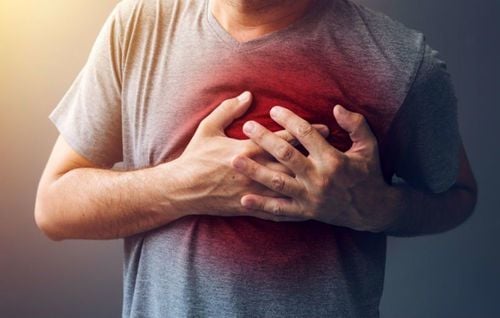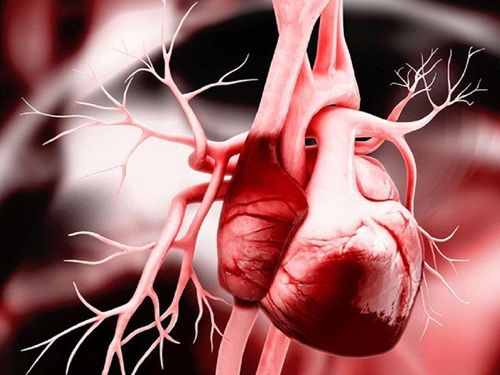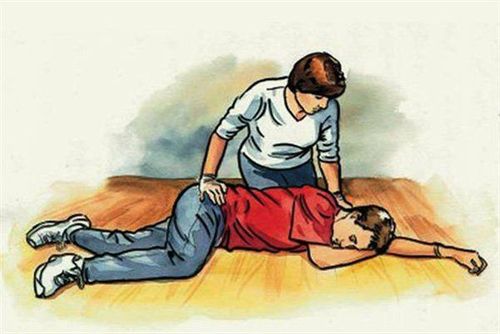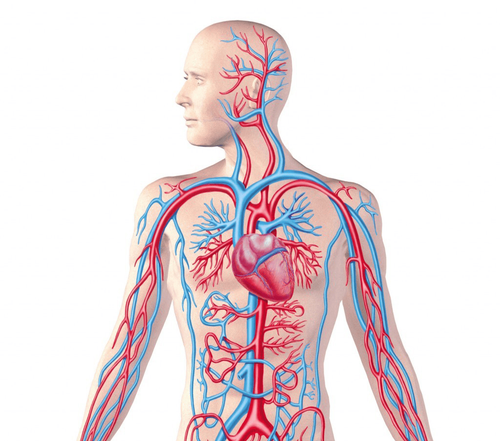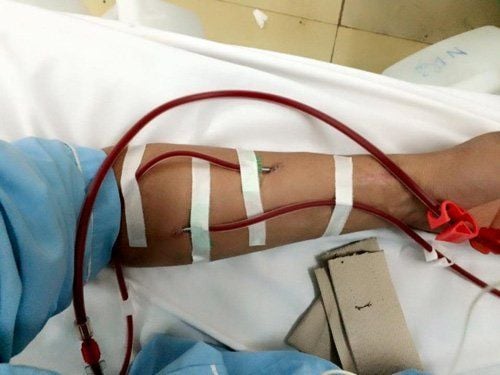This is an automatically translated article.
The article was professionally consulted by Specialist Doctor I Huynh Kim Long - Emergency Resuscitation Doctor - Emergency Resuscitation Department - Vinmec Da Nang International General Hospital.Hypovolemic shock is a very dangerous emergency involving a sudden drop in the volume of blood and body fluids, with many serious consequences and possibly death. Resuscitation in hypovolemic shock is an essential process that can save the patient's life in these cases.
1. Hypovolemic shock
Hypovolemic shock is a condition in which the perfusion of organs in the body is suddenly reduced due to the loss of a large amount of intravascular fluid, either blood loss or plasma loss. The consequence of this condition is to reduce cardiac output, increase blood flow obstruction, so the patient is deprived of blood to nourish the organ systems in the body. Hypovolemic shock needs to be detected and handled in time to avoid unwanted sequelae, on the contrary, if detected too late and cannot be resuscitated in time, the patient may have to This patient was faced with a long-term drop in blood pressure and eventually multiple failure leading to death.Some of the main causes of hypovolemic shock are:
Blood loss: Can occur due to trauma such as injury to blood vessels, rupture of solid organs or fracture of large bones in the body. ... Some other diseases such as gastrointestinal bleeding, peptic ulcer, ruptured esophageal varices... Patients with hemoptysis related to respiratory abnormalities or obstetric pathology such as ectopic pregnancy, uterine rupture, and blood loss during childbirth can also lead to hypovolemic shock due to blood loss. Dehydration: Some medical conditions lead to dehydration shock such as acute diarrhea, repeated vomiting, diabetes insipidus, use of diuretics, increased osmotic pressure, infusion of too much hypertonic solution... Patients with severe burns, heatstroke or postoperative patients with intestinal obstruction and acute pancreatitis may also experience hypovolemic shock due to dehydration. Clinical signs of hypovolemic shock include:
Vital signs: Rapid pulse is small, undetectable or difficult to capture, averaging more than 120 beats/min, capillary refill time usually greater than 2 seconds . Blood pressure drops less than 90 mmHg (systolic blood pressure) or even 40 mmHg lower than the blood pressure of normal people. Some other symptoms such as oliguria, anuria, orthostatic hypotension, sweating, dry mucous membranes, sluggishness, irritability, coma, cold skin, central venous pressure decrease compared to normal state Usually, pulmonary capillary pressure decreases, cardiac output decreases... In terms of clinical examination, some clinical test factors also help to suggest hypovolemic shock, which are:
Large blood lactate more than 3 mmol/L Hct and blood protein increase for dehydration-induced shock Red blood cells, Hb, and Hct are decreased for blood-loss shock Water, electrolyte, or acid-base disturbances If the patient has In acute pancreatitis, Lipase, Amylase will increase in these cases. If the patient experiences acute rhabdomyolysis, the CK enzyme will also be elevated.

2. Resuscitation in hypovolemic shock
Regarding the issue of circulatory resuscitation for patients in shock due to hypovolemia, some basic principles should be followed:Restore oxygen supply Prioritize fluid resuscitation, find the cause to treat thorough treatment. Combination therapy to improve the patient's health status. Emergency resuscitation for patients with hypovolemic shock includes the following initial management steps:
Survey and control the patient's airway to ensure ventilation, avoid causing respiratory complications aspiration to the patient. If the shock is due to blood loss and there is an open wound that is bleeding, it is necessary to apply a compression bandage to stop the bleeding immediately for the patient. Fix the cervical spine if the patient has signs of suspected cervical spine injury and avoid causing effects that may cause additional damage and injury to these patients. Find and proceed to place a large and sure intravenous line on the patient's body to infuse 0.9% sodium chloride solution as soon as possible. After performing first aid steps, it is necessary to transfer the patient to a medical facility that specializes in emergency resuscitation for further treatment. For first aid, put the patient in a lying position, keeping the head flat. After being taken to specialized medical facilities, resuscitation in hypovolemic shock is carried out as follows:
Provide oxygen to the patient to the maximum extent by giving the patient oxygen through the tube. nose with a concentration of 4 5 L/min or breathing with an oxygen mask at a concentration of 6 - 10 L/min. Intubation may be possible if the patient has signs of pulmonary regurgitation or respiratory failure and impaired consciousness. In some necessary cases, mechanical ventilation will be indicated. It is important to note in this step that the patient should be placed in the supine position, with the head low and the legs raised. Rehydrate the patient by inserting a large intravenous line, or a central venous catheter, for rapid infusion of 0.9% sodium chloride solution or Ringer lactate solution, followed by infusion of red blood cells according to central venous pressure. and measure the patient's mean blood pressure. HES or Gelatin can be infused while waiting for a blood transfusion, with the aim of retaining the amount of fluid in the vascular lumen, preventing the risk of continued drainage. Stop bleeding with a number of methods such as bandages on open wounds that are still bleeding, surgery may be indicated to survey and find out the source of blood flowing in the body such as the abdomen to control the amount of blood flowing from the area. this. Some valuable paraclinical techniques in diagnosing the bleeding site and the cause of bleeding in this period are angiography or gastroscopy. Treatment in combination with methods such as platelet transfusion, frozen plasma transfusion, factor VII infusion in some cases is necessary. If the patient is infused with anticoagulant Citrate and has hypocalciemia or hypomagnesemia, it can be combined with calcium chloride and magnesium chloride to control this condition. Covering blankets, using heat lamps, prophylactic antibiotics and caring for open wounds are also essential and often applied in clinical practice. It is important to note the treatment of some complications during circulatory resuscitation such as anaphylaxis, acute lung disease caused by blood transfusion.

Currently, Vinmec International General Hospital is one of the leading prestigious hospitals in the country, trusted by a large number of patients for medical examination and treatment. The team of emergency doctors and nurses at the Department are professionally trained, able to receive and handle urgent cases of serious patients. Continue to coordinate monitoring and treatment in the ICU with modern machines such as: PiCCO invasive hemodynamic probe, Prismaflex continuous dialysis machine, GE Carescape R860 ventilator...
Vinmec has a system Modern physical and equipment system: 6 ultrasound rooms, 4 DR X-ray rooms (1 full-axis scanner, 1 brightener, 1 synthesizer and 1 mammogram), 2 x-ray machines DR mobile x-ray, 2 multi-row CT scanner rooms (1 128 arrays and 1 16 arrays), 2 Magnetic Resonance imaging rooms (1 3 Tesla machine and 1 1.5 Tesla machine), 1 angiography room 2 levels of interventional blood and 1 bone mineral density measurement room.... Vinmec is also the place to gather a team of experienced doctors and nurses who will greatly assist in the diagnosis and early detection of signs. abnormality of the patient's body. In particular, with a space designed according to 5-star hotel standards, Vinmec ensures to bring the patient the most comfort, friendliness and peace of mind.
Please dial HOTLINE for more information or register for an appointment HERE. Download MyVinmec app to make appointments faster and to manage your bookings easily.






